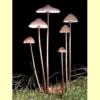
images/Mycena_cystidiosa/Mycena_cystidiosa_KRT2773.jpg
Tall agaric (stipe to 205 mm long) with a relatively small pileus (to 27 mm diam.), growing on litter or rarely wood, with a white spore print. Pileus brown, not viscid. Lamellae adnexed or adnate. Stipe central. Partial veil remnants absent. Spores hyaline, amyloid, smooth; germ pore absent. Cheilocystidia present; pleurocystidia thick-walled, with apical horns. Lamellar trama regular. Pileipellis a cutis, composed of nodulose hyphae. Clamp connections present.
Mycena cystidiosa differs from other brown, non-caespitose
Mycena species on litter by the rather stiff, tall stipe (to more than 200 mm long) and the presence of abundant criniform stipes. Microscopically,
M. hispida is very distinctive by virtue of the thick-walled pleurocystidia with apical horns. The closest species of
Mycena is
M. austrofilopes, which can also have a long stipe, but that has a greyish pileus with a white bloom around the centre. Fruit-bodies of
M. cystidiosa can be rather tough in texture.
Marasmius is similarly tough, but the stipes are usually very dark to black, resembling horsehair, or otherwise distinctly paler near the apex. In addition, the spores are not amyloid and the pileipellis is a hymeniderm.
One species:
Mycena cystidiosa (=
M. hispida). This is the sole member of
Mycena section
Metuloidiferae. It is keyed out separately because its texture is a little tougher than other species of
Mycena, and therefore, in the field it could be confused with
Marasmius. It also has some distinctive microscopic features.
Mycena cystidiosa (G.Stev.) E.Horak,
New Zealand J. Bot. 9: 417 (1971).
N.S.W., Vic. and Tas. (and possibly also Qld).
In native forests.
On litter or rarely wood.
Saprotrophic.
Fuhrer, B. (2005),
A Field Guide to Australian Fungi. Bloomings Books, Hawthorn. [
Description and
Illustration of
M. cystidiosa]
Fuhrer, B. & Robinson, R. (1992), Rainforest Fungi of Tasmania and South-east Australia. CSIRO Press, East Melbourne. [Illustration of M. cystidiosa (as hispida)]
Grgurinovic, C.A. (1997a), Larger Fungi of South Australia. The Botanic Gardens of Adelaide and State Herbarium and The Flora and Fauna of South Australia Handbooks Committee, Adelaide. [Description, Illustration and Microcharacters of M. cystidiosa]
Grgurinovic, C.A. (2003), The genus Mycena in south-eastern Australia. Fungal Diversity Press, Hong Kong and Australian Biological Resources Study, Canberra. [Description, Illustration, B&W Illustration and Microcharacters for M. cystidiosa]
McCann, I.R. (2003), Australian Fungi Illustrated. Macdown Productions, Vermont. [Illustration of M. cystidiosa]
Shepherd, C.J. & Totterdell, C.J. (1988), Mushrooms and Toadstools of Australia. Inkata Press, Melbourne. [B&W Illustration of M. cystidiosa (as M. aff. eucalyptorum)]


_sml.jpg)

_AM_28_sml.jpg)
